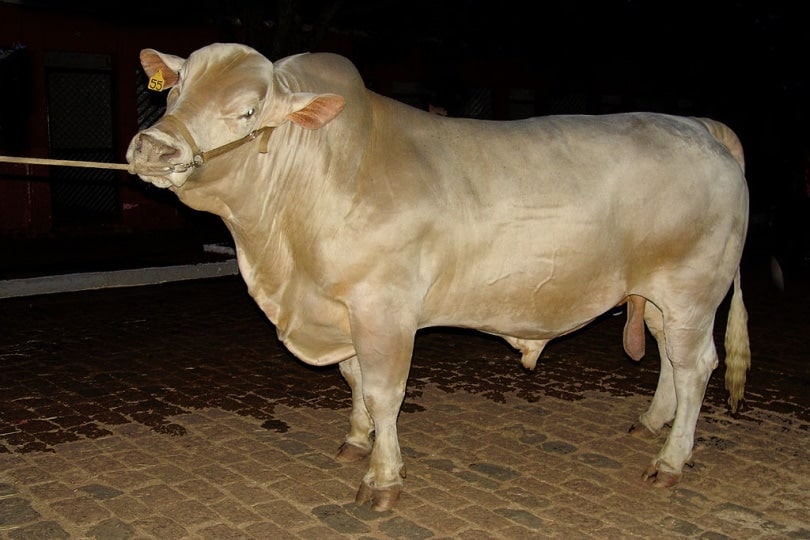The Canchim cattle breed is a cross between a Brazilian Zebu and a European Charolais cattle breed. They have a long history in Brazil, from where they originate, where they were bred to improve the country’s meat production. However, could a small-scale farmer profit from the Canchim cattle breed? Let’s take a look at the facts.

Quick Facts about Canchim Cattle
| Breed Name: | Canchim Cattle |
| Place of Origin: | Brazil |
| Uses: | Beef farming |
| Male Size: | 2,000 lbs |
| Female Size: | 900 – 1,300 lbs |
| Color: | White, light beige |
| Lifespan: | 15 – 20 years |
| Climate Tolerance: | Prefers warmer climates |
| Care Level: | Medium |
| Production: | High beef yield |
Canchim Cattle Origins
The Canchim breed are the product of crossbreeding to increase the beef yield of Brazilian cattle. They are a crossbreed of the Zebu cattle and the Charolais cattle. The Charolais cattle breed was a superior beef farming cattle to the Zebu when observed. However, the Charolais don’t tolerate hot climates well. So, agricultural authorities began crossbreeding the Charolais with the Zebu cattle to improve the Charolais’ heat tolerance and the Zebu’s beef yield.
Additionally, Charolais cattle were very susceptible to Brazilian pathogens that their European ancestors were unfamiliar with. Crossbreeding with the Zebu cattle allowed the Charolais cattle to improve their immune system when exposed to the pathogens in their new home.
The Brazilian Association of Canchim Cattle Breeders was first formed in 1971, after establishing the breed in Brazil, and the Ministry of Agriculture recognized the Canchim Cattle as a standalone Cattle Breed in 1983.

Canchim Cattle Characteristics
The Canchim cattle breed are fast-growing cattle that produce a high beef yield. Most beef cattle are slaughtered between 21 and 26 months of age when they weigh between 900 and 1,300 pounds. Genetically, Canchim cattle must be around ⅝ Charolais and ⅜ Zebu in heritage to be considered part of the breed.
The Canchim cattle also have superior pathogen resistance and tolerate heat very well because of their Zebu heritage. They breed readily, efficiently, and quickly making them fantastic for beef farming, but generally have less milk yield than beef yield.
Canchim Cattle Uses
The Canchim are primarily used for beef farming because the calves grow quickly and produce a high amount of beef. While cows may be used for milk farming, they aren’t popular because their beef production is higher.
Canchim Cattle Appearance & Varieties
The Canchim cattle breed have a distinct white to light beige coloring and a hump on their back from their Zebu heritage. The white color with the hump makes them very hard to mistake for another breed of cow.
Canchim Cattle Population, Distribution, & Habitat
The Canchim are primarily found in Brazil and South America. They’ve been introduced to other locations, but since they are more suited to warmer climates and aren’t as adaptable, they aren’t as widespread as some other cattle breeds.
Are Canchim Cattle Good for Small-Scale Farming?
Canchim cattle don’t do well for small-scale farming. Since they’re primarily beef cattle, they don’t do well in small-scale agriculture, usually focusing on milk cattle. Since beef cattle have a lower per-year yield than milk cattle, small-scale farmers will want to try to raise Canchim cattle.
See Also:

Final Thoughts: Canchim Cattle Breed
Small-scale farming is erupting worldwide as people investigate a more sustainable and self-sufficient way of living. Unfortunately, Canchim cattle aren’t appropriate for small-scale farms because of their low per-year yields. However, they’re still a famous cattle breed for warm-weather beef farmers that aren’t going anywhere any time soon!
Featured Image Credit: Touro_Canchim,José Reynaldo da Fonseca, Creative Commons Attribution 2.5 Generic
